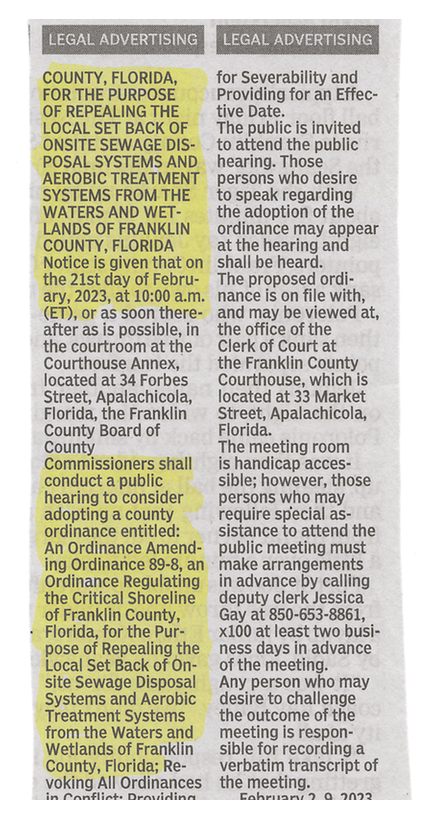UPDATED February 22, 2023
Thank you Franklin County Residents for your responsiveness and care of our natural habitat.
Thank you Board of County Commissioners for protecting our wetlands and waterways by keeping the current wetlands-septic rule fully intact.
**************************************
February 14, 2023
Franklin County has been a leader in Florida by protecting wetlands and critical habitat. Let’s keep it that way for decades to come! Contact your County Commissioners today. Let them know that protecting Franklin County’s water and wetlands is important to you. Wetlands protect our commercial fisheries, recreational fishing & tourism, and the related economy.
Most importantly, please urge your commissioner to reject a recently proposed change to the existing wetlands-septic setback rule. Keep the current wetlands rule (ordinance) intact.
This recently proposed ordinance (or rule) will weaken current wetlands protection  by changing the requirement on septic tank set back distance from wetlands of 75 feet to 50 feet.**
by changing the requirement on septic tank set back distance from wetlands of 75 feet to 50 feet.**
The Franklin BOCC will consider this new proposed rule on Feb 21 at 10 AM. There is also a Zoom option.
Below is Franklin County’s current language in the County’s Ordinances under the section “Guidelines and Minimum Standards for Development in the Critical Shoreline District”…
Within 75 feet of the Waters and Wetlands of Franklin County neither onsite sewage disposal systems nor aerobic treatment systems shall be allowed. Within 75 feet to 150 feet of the Wetlands of Franklin County and in areas not served by a central wastewater system, aerobic treatment systems shall be required. Onsite sewage disposal systems and their associated absorption beds, including subsurface or mounds, shall be prohibited…..”
Please thank Franklin County for their leadership in protecting our wetlands and water.
Commissioner Cheryl Sanders – [email protected] – 850-697-2534
Commissioner Ottice Amison – [email protected] – 850-653-7860
Commissioner Ricky Jones – [email protected] – 850-670-4427
Chairman Noah Lockley – [email protected] – 850-653-4452
Commissioner Jessica Ward – [email protected] – 850-323-032
Resources
**Environmental / Public Health Impacts from Septic Systems
- Even properly operated septic systems can contaminate wetlands and surface water. Groundwater flowing underneath a drain field captures any remaining contaminants released from the septic system.
- Our stream, lakes, or coastal waters are at greater risk of becoming contaminated when they are in the path of groundwater flow beneath a septic system.
- Our ground water is shallow, and allows nutrients like nitrogen and phosphorus, and harmful bacteria and viruses to discharge into wetlands, rivers, and bays.
- Contaminants to wetlands/water can damage our fragile ecosystem/environment at much lower levels than damage to human health.
- When there are too many nutrients in surface water, they act as a fertilizer for fast-growing bacteria and algae. This can lead to algal blooms that reduce water quality, kill aquatic animals and plants, and form toxins. These nutrients are also a food source for red tide, which increases the amount of time red tide stays in the area.
- The closer septic tanks are to water and the more developed our area becomes, the worse contamination gets the more damage is done. For example, instead of one septic system on a thirty-acre lot, thirty one-acre lots and thirty septic systems, raises the likelihood of damage to wildlife habitat and biodiversity.
- Coastal waters are more sensitive to nitrogen contamination from septic systems.
- Freshwater rivers, lakes, and ponds are more sensitive to phosphorus contamination from septic systems. Read More
- Types of Septic Systems
References
https://sustainablecitycode.org/brief/restrict-septic-systems-near-significant-wildlife-habitats/
https://www.epa.gov/septic/septic-system-impacts-water-sources
USGS: Why are wetlands important?
“Wetlands provide habitat for thousands of species of aquatic and terrestrial plants and animals. Wetlands are valuable for flood protection, water quality improvement, shoreline erosion control, natural products, recreation, and aesthetics.
Wetlands are among the most productive habitats on earth providing shelter and nursery areas for commercially and recreationally important animals like fish and shellfish, as well as wintering grounds for migrating birds. Coastal marshes are particularly valuable for preventing loss of life and property by moderating extreme floods and buffering the land from storms; they also form natural reservoirs and help maintain desirable water quality.” More

